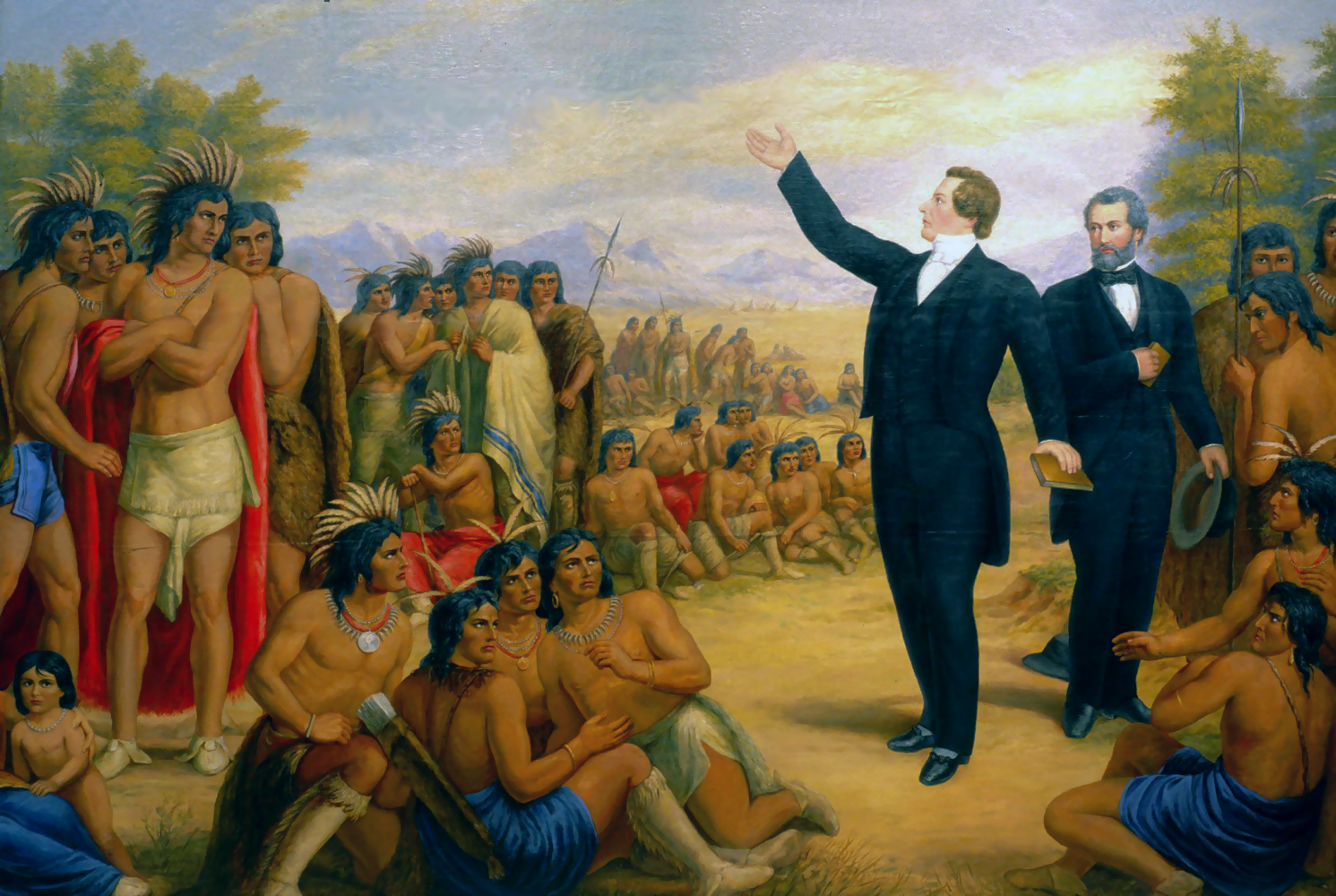
北米先住民とモルモン教
Native American people and Mormonism

Painting which hung in the
Salt Lake Temple of Mormon founder Joseph Smith preaching to Native
Americans in Illinois
☆ 過去2世紀にわたって、ネイティブアメリカンとモルモン教徒の関係には、友好関係、疎外、戦い、奴隷制度、教育プログラム、公式・非公式の差別などが含ま れてきた。[1] ネイティブアメリカン(アメリカンインディアンとも呼ばれる)は、モルモン教の信奉者たちから、歴史的に特別なグループと考えられてきた。なぜなら、彼ら は『モルモン書』に登場するレーマン人(Lamanite)の子孫であると考えられていたからだ。。[2]:196[3] 遺伝学や考古学の研究では、モルモン書の史実性や、ネイティブアメリカンが中東を起源とするという説を裏付けるものは何も見つかっていない。[4][5] [6] 現在、モルモン教にはネイティブアメリカンの信者が多くいるが、一方でモルモン教やその教え、ネイティブアメリカンに対する行動を批判する人々も数多くい る。[7]
| Over the past two centuries, the relationship between Native American people and Mormonism
has included friendly ties, displacement, battles, slavery, education
placement programs, and official and unofficial discrimination.[1]
Native American people (also called American Indians) were historically
considered a special group by adherents of the Latter Day Saint
movement (Mormons) since they were believed to be the descendants of
the Lamanite people described in The Book of Mormon.[2]: 196 [3] There
is no support from genetic studies and archaeology for the historicity
of the Book of Mormon or Middle Eastern origins for any Native American
peoples.[4][5][6] Today there are many Native American members of
Mormon denominations as well as many people who are critical of
Mormonism and its teachings and actions around Native American
people.[7] |
過去2世紀に
わたって、ネイティブアメリカンとモルモン教徒の関係には、友好関係、疎外、戦い、奴隷制度、教育プログラム、公式・非公式の差別などが含まれてきた。
[1]
ネイティブアメリカン(アメリカンインディアンとも呼ばれる)は、モルモン教の信奉者たちから、歴史的に特別なグループと考えられてきた。なぜなら、彼ら
は『モルモン書』に登場するレーマン人(Lamanite)の子孫であると考えられていたからだ。。[2]:196[3]
遺伝学や考古学の研究では、モルモン書の史実性や、ネイティブアメリカンが中東を起源とするという説を裏付けるものは何も見つかっていない。[4][5]
[6]
現在、モルモン教にはネイティブアメリカンの信者が多くいるが、一方でモルモン教やその教え、ネイティブアメリカンに対する行動を批判する人々も数多くい
る。[7] |
| History Under Joseph Smith The founder of Mormonism, Joseph Smith, was fascinated by Native Americans from an early age.[8]: 275 Scholars Lori Taylor and Peter Manseau believe religious teachings of then deceased Handsome Lake relayed through his nephew Red Jacket near Smith's town influenced the 16-year-old Smith.[9][10] Smith later stated that in 1823 a Native American angel visited him and told him about a record that contained an ancient history of Native Americans.[8]: 276 Smith said he translated this record from golden plates to The Book of Mormon. Smith stated in the 1842 Wentworth Letter to a Chicago newspaper editor that the book was "the history of ancient America ... from its first settlement by a colony that came from the Tower of Babel ... to the beginning of [400 CE] ... The remnant are the Indians that now inhabit this country."[11][12][13] Throughout the 1800's, adherents cited the common belief of White Christians at the time that Native Americans were "red sons of Israel" descended from the lost tribes as evidence of the authenticity of The Book of Mormon account.[8]: 277 [14] 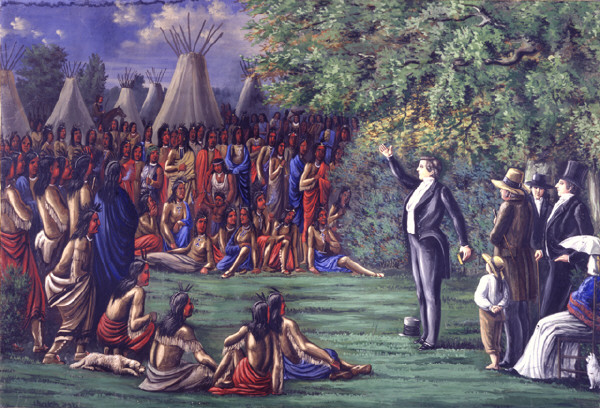 Artist's depiction of Joseph Smith preaching to the Sac and Fox Indians who visited Nauvoo, Illinois, in 1841 Adherents saw Native Americans as part of God's chosen people and they believed that preaching to them was part of the gathering of Israel which will precede the millennium.[18] The church's long history with Native Americans is tied to their beliefs about The Book of Mormon.[8]: 277, 279 According to sociologist Marcie Goodman, historically Latter Day Saints held paternalistic beliefs about Native Americans needing help.[16] Outreach to Native Americans became the first mission of Smith's newly organized Church of Christ, as the purpose of The Book of Mormon was to recover the lost remnant of the ancient children of Israel (e.g. Native Americans).[21] Smith sent prominent members Oliver Cowdery, Parley Pratt, Peter Whitmer, Jr., and Ziba Peterson to a "Lamanite Mission" only six months after organizing the church.[19]: 122 Though they did not have any converts and reception was lukewarm among the Seneca, Wyandot, and Shawnee people, they were well received by the Delaware people because The Book of Mormon advocated for a divine destiny for Native Americans and a divine right to their territory in the American "promised land".[20]: 96–100 [2]: 196, 200 During the 1840s, Smith sent missionaries to the Sioux (Dakota), Potawatomi (Bodéwadmi), Stockbridge (Mahican) people in Wisconsin and Canada. Additionally, representatives from the Sauk (Asakiwaki) and Fox (Meskwaki) people met with Smith at the Latter Day Saint headquarters in Nauvoo, Illinois.[22][23]: 492 Smith was quoted in a Nauvoo Council of Fifty meeting as stating "If the Lamanites won't hearken to our council, they shall be oppressed & killed until they will do it."[24][25] Counselor Orson Spencer stated subsequently that "The gospel to [Native Americans] is, they have been killed and scattered in consequence of their rejecting the everlasting Priesthood, and if they will return to the Priesthood and hearken to council, they shall have council enough, that shall save both them and us."[24][25] Later, Potawatomi leaders asked the Mormons to join them in an alliance with some other tribes, but Smith declined.[22] The governor of Iowa John Chambers was wary of these meetings which were reported to him by interpreter Hitchcock, as Chambers believed Smith was "an exceedingly vain and vindictive fellow" who might use an alliance with Potowatomi people to start a conflict to seek revenge against Missouri.[23]: 500–501 |
歴史 ジョセフ・スミスのもとで モルモン教の創始者ジョセフ・スミスは幼い頃からネイティブアメリカンに魅了されていた。[8]: 275 学者のロリ・テイラーとピーター・マンソーは、ハンサム・レイクの死後、彼の甥であるレッド・ジャケットがスミスの町近くでハンサム・レイクの宗教的教え を伝えたことが、16歳のスミスに影響を与えたと考えている。 。スミスは後に、1823年にネイティブアメリカンの天使が現れ、ネイティブアメリカンの古代の歴史が記された記録について告げられたと述べた。[8]: 276 スミスは、この記録を金の板からモルモン書に翻訳したと述べた。スミスは1842年のシカゴの新聞編集者宛てのウェントワース書簡の中で、この書物は「古 代アメリカの歴史...バベルの塔からやってきた植民地による最初の入植から...西暦400年の初頭まで... 残ったのは、現在この国に住んでいるインディアンである」[11][12][13] 1800年代を通じて、信奉者たちは、ネイティブアメリカンは失われた部族の子孫である「イスラエルの赤い息子」であるという当時の白人キリスト教徒の一 般的な考えを、モルモン書の記述の信憑性を証明する証拠として引用していた。[8]:277[14]  1841年にイリノイ州ノーブーを訪れたサック・アンド・フォックス族インディアンに説教するジョセフ・スミスを描いた画家の絵画 信者たちは、ネイティブアメリカンを神に選ばれた民の一部と見なし、彼らに伝道することは千年期に先立って行われるイスラエルの民の収集の一部であると信 じていた。[18] 教会とネイティブアメリカンとの長い歴史は、モルモン書に関する彼らの信念と結びついている。[8]: 277, 279 社会学者のマーシー・グッドマンによると、歴史的に末日聖徒はネイティブアメリカンを助けが必要な人々であると考える温情主義的な信念を持っていた。[1 6] ネイティブアメリカンへの布教は、スミスが新たに組織したキリスト教会の最初の使命となった。モルモン書の目的は、古代イスラエルの失われた子孫(例えば ネイティブアメリカン)を回復することだったからである。[21] スミスは教会を組織してからわずか6か月後に、著名な会員であるオリバー・カウドリ、パーリー・プラット、ピーター・ホイットマー・ジュニア、ジバ・ピー ターソンを「レーマン人宣教」に派遣した。[19 :122 彼らは改宗者を獲得することはできず、セネカ族、ワイアンドット族、ショーニー族の間では反応は冷ややかだったが、デラウェア族の間では好意的に受け入れ られた。モルモン書は、アメリカ先住民に神聖な運命と、アメリカ「約束の地」における神聖な領土権を提唱していたからである。[20]:96-100 [2]:196,200 1840年代、スミスはウィスコンシン州とカナダに住むスー族(ダコタ族)、ポタワトミ族(ボドワドミ族)、ストックブリッジ族(マヒカン族)に宣教師を 派遣した。さらに、ソーク族(アサキワキ族)とフォックス族(メスキワキ族)の代表者がイリノイ州ノーブーにある末日聖徒の本部でスミスと会談した。 [22][23]:492 スミスはノーブーの50人評議会で「もしレーマン人が我々の勧告に従わないのであれば、彼らが従うまで彼らを圧迫し、殺すだろう」と述べたと引用されてい る。」と述べたと引用された。[24][25] その後、オルソン・スペンサー顧問は「(ネイティブアメリカンへの)福音とは、彼らが永遠の神権を拒絶した結果として殺され、散り散りになったということ だ。そして、彼らが神権に戻り、協議会に耳を傾けるのであれば、彼らと我々双方を救うのに十分な協議会が与えられるだろう」と述べた。[24][25] その後、ポタワトミ族の指導者たちは モルモン教徒に他の部族との同盟に加わるよう求めたが、スミスはこれを断った。[22] アイオワ州知事ジョン・チェンバースは、通訳のヒッチコックから報告されたこれらの会合を警戒していた。チェンバースは、スミスを「非常に虚栄心が強く執 念深い男」であり、ポトワトミ族との同盟関係を利用してミズーリへの復讐のために紛争を起こす可能性があると信じていた。[23]:500-501 |
| Under Brigham Young See also: Native Americans in Utah § Mormon Pioneers, and Mormon settlement techniques of the Salt Lake Valley After Smith's death and six months of a succession crisis, Brigham Young became leader of the majority of Smith's followers and the largest denomination in the Latter Day Saint movement, The Church of Jesus Christ of Latter-day Saints (LDS Church). Young discussed an alliance with some Native American nations with other top leaders but these efforts were abandoned in 1846 as Young's followers were preparing to migrate west.[22] According to former Church Historian and emeritus church Seventy Marlin Jensen, before Mormon colonization of the region there were about 20,000 Native American people in the Great Basin.[29] These included the Shoshone, Goshute, Ute, Paiute, and Navajo nations.[27][28]: 273 The settlers initially had some peaceful relations, but because resources were scarce in the desert, hostilities broke out.[27] As tens of thousands of LDS colonizers arrived and took over the land, and resources Native Americans had used for thousands of years diminished, native nations felt they had to resist for their survival.[26]: 21—23 [27] By the 1850s there were already hundreds of Mormon colonial settlements made in the Mountain West stretching hundreds of miles from Idaho to Southern California, and Young petitioned the federal government to remove all Native people to distant reservations.[30]: 227–228 Relationship during Utah War Mormon relations with Native Americans were a significant factor in President Buchanan's decision to order the U.S. army to Utah, beginning a conflict that would later be called the Utah War.[31] Brigham Young and other church leaders taught that by accepting baptism and intermarriage with Mormons, Native Americans would fulfill a Book of Mormon prophecy that Lamanites would return to the House of Israel.[31] While it is no longer a core tenant of the Latter-day faith, at the time leaders taught that "the time had arrived when all the wicked should be destroyed from the face of the earth, and that the Indians would be the principal means by which this object should be accomplished."[31]: 76 Gaining Native American allies was a key part of Brigham Young's strategy to maintain independence from the United States.[31] In 1855 Brigham Young called 160 missionaries to preach to North American Native Americans from the west coast to the Mississippi; over the next three years at least three hundred missionaries would construct mission forts among tribes along major immigration trails.[31] In a report to the commissioner of Indian affairs, Garland Hurt wrote, "There is perhaps not a tribe on the continent that will not be visited... [to create] a distinction in the minds of the Indian tribes of this Territory between the Mormons and the people of the United States."[31]: 76 Reports from Indian agents across the country confirmed Hurt's claims.[31] Furthermore, in the spring of 1857, Brigham Young violated federal law when he travelled outside of his jurisdiction as Utah's Superintendent of Indian affairs to meet with Native American leaders throughout the Oregon territory and give them gifts, which he later falsely reported were presents he gave to Indians in Utah.[31] Federal law made it a crime to alienate Indians from the United States government, and the president had the power to use military force to stop anyone attempting to do so.[31] As continuing problems from the territory became harder for US politicians to ignore, Stephen A. Douglas stated that "The Mormon Government, with Brigham Young at its head, is now forming alliance with Indian tribes in Utah and adjoining territories--stimulating the Indians to acts of hostility."[31]: 142 Despite public denials of this accusation, Nauvoo Legion commanders were concurrently ordered to warn Native Americans that they must unite together with the Mormons against the US government or be killed off by Americans separately.[31] As Brigham Young cut off emigration routes between the Eastern states and California (blaming Native American violence for the closures) President Buchanan ordered the US army to escort a new governor and Superintendent of Indian Affairs to the Utah territory.[31] Ultimately, while Mormons were able to establish some alliances with Southern Paiute tribes, the refusal of tribes in the north of Utah disrupted one of Brigham Young's primary war strategies.[31] In particular, Young was taken by surprise by the Bannock and Shoshone attack on the Mormon missionary Fort Lemhi for the benefit of the US troops.[31][32] This miscalculation of Native American alliances led him to begin overtures of peace with the US army.[31][32] |
ブリガム・ヤングの下で 参照:ユタ州のネイティブアメリカン § モルモン教の開拓者たち、ソルトレイクバレーへのモルモン教徒の入植方法 スミスが死去し、その後継者問題が6か月間続いた後、ブリガム・ヤングはスミスの信者の大半と末日聖徒イエス・キリスト教会(モルモン教会)という末日聖 徒イエス・キリスト教会最大の宗派の指導者となった。ヤングは他の指導者たちとともに、いくつかのネイティブアメリカン国家との同盟について協議したが、 これらの努力は1846年にヤングの信奉者たちが西への移住の準備を進める中で放棄された。[22] 元教会史家で名誉教会七十人のマーリン・ジェンセンによると、モルモン教徒によるこの地域の植民地化以前には、グレート・ベイスンには約2万人のネイティ ブアメリカンが暮らしていた。[29] これには、 ショショーニ族、ゴシュート族、ユテ族、パイユート族、ナバホ族の国民が含まれていた。[27][28]: 273 開拓者たちは当初は平和的な関係を築いていたが、砂漠では資源が乏しかったため、敵対関係に発展した。[27] 末日聖徒イエス・キリスト教会の入植者が数万人単位で到着し、土地を占領し、先住民が何千年にもわたって利用してきた資源が減少したため、 先住民たちは自分たちの生存のために抵抗しなければならないと感じた。[26]: 21-23 [27] 1850年代には、アイダホから南カリフォルニアまで数百マイルにわたる山岳西部にすでに数百のモルモン植民地が作られており、ヤングは連邦政府に先住民 を遠く離れた保留地に移住させるよう嘆願した。[30]: 227-228 ユタ戦争中の関係 モルモン教徒とアメリカ先住民との関係は、ブキャナン大統領がユタ州に米軍を派遣し、後に「ユタ戦争」と呼ばれることになる紛争を開始する決定を下すにあ たって、重要な要因となった。[31] ブリガム・ヤングをはじめとする教会指導者たちは、モルモン教徒の洗礼を受け、彼らと結婚することで、アメリカ先住民は『モルモン書』の預言である「レー マン人がイスラエルの家に帰ってくる」という預言が成就すると教えた。[31] 末日聖徒の信仰の中心的な教義ではなくなったが、当時指導者たちは「地上から悪人がすべて滅ぼされる時が到来し、その目的を達成する主な手段としてイン ディアンが利用される」と教えた[31]:76。 ネイティブアメリカンを同盟者として獲得することは、アメリカ合衆国からの独立を維持するというブリガム・ヤングの戦略の重要な一部であった[31]。 1855年、ブリガム・ヤングは160人の宣教師を西海岸からミシシッピまでの北米先住民に布教するよう呼びかけた。その後3年間に少なくとも300人の 宣教師が主要な移住ルート沿いの部族の間に伝道基地を建設した。[31] ガーランド・ハートは、インディアン問題担当委員への報告書で、「おそらくこの大陸には、訪問されない部族はないだろう... この領土のインディアン部族の間で、モルモン教徒とアメリカ国民の間に区別が生じるだろう」と述べた。[31]:76 アメリカ中のインディアン担当官からの報告書は、ハートの主張を裏付けた。[31] さらに、 1857年の春、ブリガム・ヤングはユタ州のインディアン問題担当官として管轄外のオレゴン領を訪れ、先住民の指導者たちと会って贈り物を渡したが、これ は後にユタ州のインディアンに贈ったと偽って報告したものである。 連邦法では、アメリカ政府からインディアンを離反させることは犯罪とされており、大統領にはそれを阻止するために軍事力を行使する権限があった。[31] 領土における問題が継続し、アメリカの政治家たちがそれを無視することが難しくなると、スティーブン・A・ダグラスは「ブリガム・ヤングを長とするモルモ ン政府は、現在ユタ州および隣接する領土のインディアン部族と同盟を結ぼうとしている。そして、インディアンたちに敵対行為を促している」と述べた。 [31]:1 42 この非難を公に否定したにもかかわらず、ノーブー軍団の司令官は、ネイティブアメリカンに対して、モルモン教徒と団結してアメリカ政府と戦わなければ、ア メリカ人によって皆殺しにされると警告するよう命じられていた。[31] ブリガム・ヤングが東部諸州とカリフォルニア間の移住ルートを遮断したため(ネイティブアメリカンの暴力が原因だと非難した)、ブキャナン大統領は、ユタ 準州に新しい知事とインディアン問題監督官を護衛するよう米軍に命じた。[31] 最終的に、モルモン教徒は南パイユート族といくつかの同盟関係を築くことができたが、ユタ州北部の部族が拒否したことで、ブリガム・ヤングの主要な戦争戦 略のひとつが崩壊した。[31] 特に、ヤングは モルモン宣教師のフォート・レムヒ砦に対するショショーニ族とバノック族による攻撃は、アメリカ軍の利益のために行われたものであり、[31][32] このネイティブアメリカン同盟の誤算により、彼はアメリカ軍との和平交渉を開始した。[31][32] |
| Young's policies after the Utah War By 1860 the population of Mormon migrants in Utah had grown to 40,000 and within another ten years that number had doubled to 86,000.[28]: 266 By 1890 Native Americans made up only 1.6% of Utah's population.[33]: 112 Over a century later in 2010 that number had remained about the same at 1.3%.[34] Within 50 years of Mormon settlement the population of Utah's Native Americans had gone from 20,000 to under 2,700, a large decline of 86%.[28]: 273 Young stated, "towards so degraded and ignorant a race of people, it was manifestly more economical and less expensive, to feed and clothe, than fight them."[38] Of the monumental LDS colonization of the Intermountain West LDS leader Jensen stated, "Regardless of how one views the equities of Indian-Mormon relations in those times, the end result was that the land and cultural birthright Indians once possessed in the Great Basin were taken from them. ... [T]he least we can do from a distance of 160 years, is to acknowledge and appreciate the monumental loss this represents on the part of Utah's Indians. That loss and its 160-year aftermath are the rest of the story."[39][26]: 24 Young taught that cursed racial lineages were in a three-tiered classification of redemption with Lamanites (Native Americans) on top, Jewish people in the middle, and Cain's descendants (Black people) on the bottom.[2]: 205–206 This corresponded to the time when they would each receive the gospel, with Native Americans in the foreseeable future, Jewish people after they were gathered at the Second Coming of Jesus Christ, and Black people in the afterlife during the resurrection.[2]: 205–206 Young sent Jacob Hamblin as a leader for several missionary efforts among Great Basin Native Americans resulting in important Hopi conversion of Chief Tuba.[40] In the 1890s, James Mooney of the Smithsonian Institution of the Bureau of American Ethnology, and Missouri military commander Nelson Miles, placed some blame on Mormon settlers for the events that precipitated the Wounded Knee Massacre.[41]: 94, 97 Some later scholars perpetuated these ideas, however, historical evidence does not support them.[41]: 89 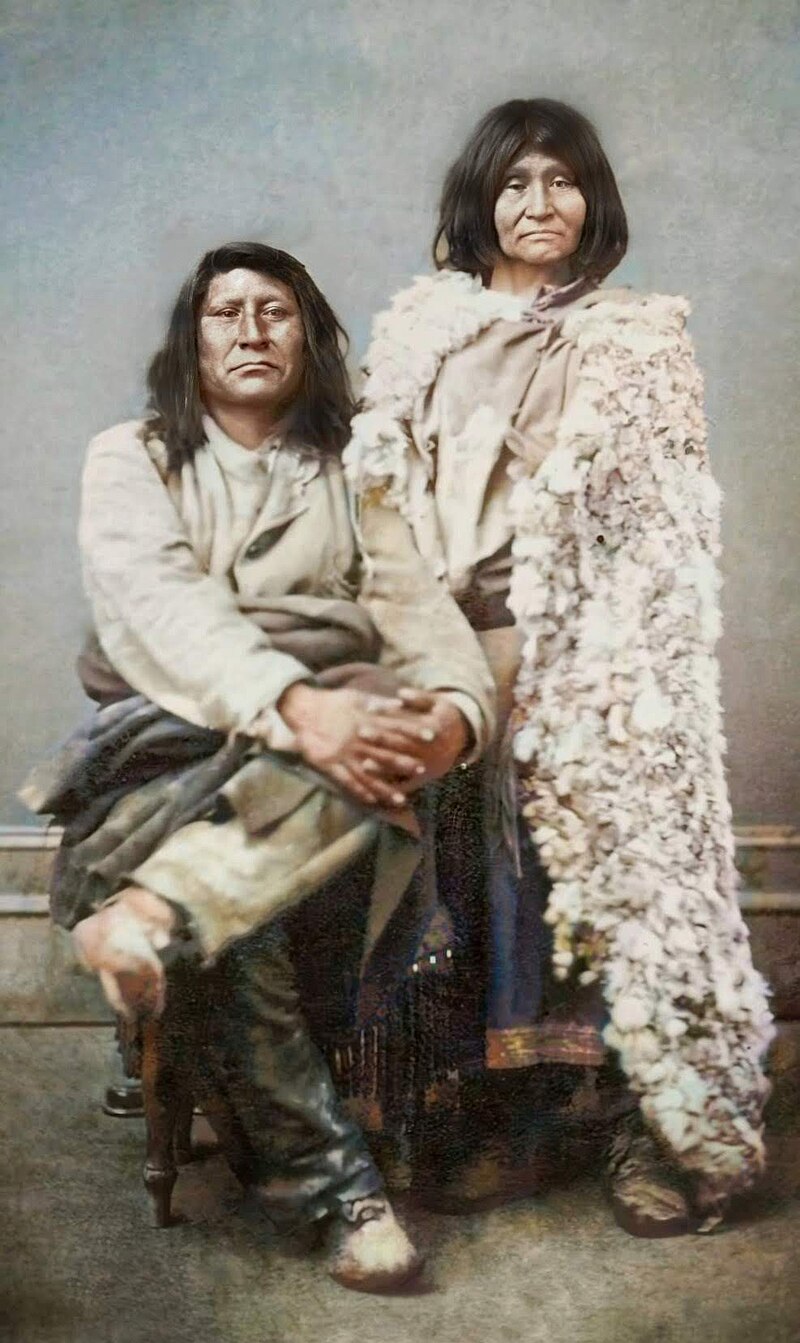 Chief Sagwitch and spouse Beawoachee, circa 1875 Though, nearly killed by US soldiers in the 1863 Bear River Massacre, Chief Sagwitch became a notable ally of Young and church member by 1873. 100 of his people were also baptized into the LDS Church, and they settled and farmed in Washakie, Utah. They also contributed large amounts of labor towards the building of the Logan Utah Temple in the 1870s and 80s.[42]: xiv, 174 Sagwitch's grandson Moroni became the first Native American bishop in the LDS Church.[42]: xiv |
ユタ戦争後のヤングの政策 1860年までにユタ州に移住したモルモン教徒の人口は4万人に達し、さらに10年後にはその数は倍増して8万6千人となった。[28]: 266 1890年には、ユタ州の人口に占めるネイティブ・アメリカンの割合はわずか1.6%であった。[33]: 112 それから1世紀以上経った2010年には、 2010年時点でも、その割合は1.3%とほぼ同じであった。[34] モルモン教徒入植から50年以内に、ユタ州のネイティブアメリカンの人口は20,000人から2,700人以下へと、86%も減少した。[28]: 273 ヤングは「これほどまでに堕落し、無知な人種に対しては、 彼らと戦うよりも、彼らに食料と衣服を与える方が明らかに経済的で費用もかからない」と述べた。[38] ジェンセンLDS指導者は、LDSによる内陸西部の植民地化について、「その時代におけるインディアンとモルモン教徒の関係をどう見るかに関わらず、最終 的な結果は、グレート・ベイスンでかつてインディアンが所有していた土地と文化的な権利が彼らから奪われたということだ。... [T] 160年の時を経て、少なくとも我々にできることは、ユタ州のインディアンにとってこのことが意味する途方もない損失を認め、感謝することだ。その損失と 160年間にわたる余波が、この物語の続きである」[39][26]: 24 ヤングは、呪われた人種は3段階の救済の分類に当てはまると教えた。最上位にラマナイ人(アメリカ原住民)、中間にユダヤ人、最下位にカインの子孫(黒 人)が位置づけられるというのだ。[2]: 205–206 これは、それぞれが福音を受け取る時期に対応しており、 アメリカンが近い将来、ユダヤ人がイエス・キリストの再臨の際に集められた後、黒人が復活の際に来世で、それぞれ福音を受け取る時期と一致していた。 [2]: 205–206 ヤングは、グレート・ベイスンに住むネイティブ・アメリカンに対する複数の宣教活動のリーダーとしてジェイコブ・ハンブリンを派遣し、その結果、チューバ 酋長が重要なホピ族の改宗を果たした。[40] 1890年代、スミソニアン協会アメリカ民族学局のジェームズ・ムーニーとミズーリ州の軍司令官ネルソン・マイルズは、ウーンデッド・ニーの虐殺を招いた 出来事について、モルモン教徒入植者にも責任の一端があるとした。[41]: 94, 97 しかし、後世の学者の中には、これらの考えを永続させた者もいるが、歴史的証拠はそれを裏付けていない。[41]: 89  1875年頃のサグウィッチ酋長(チーフ)と配偶者のビアウォーチー 1863年のベア・リバー虐殺事件で米軍兵士に殺されそうになったものの、サグウィッチ酋長は1873年までに、ヤングの著名な協力者となり、教会の会員 となった。彼の民のうち100人が末日聖徒イエス・キリスト教会で洗礼を受け、ユタ州ワシャキーに定住して農業を営んだ。また、1870年代から80年代 にかけて、ユタ州ローガン神殿の建設に多くの労働力を提供した。[42]: xiv, 174 サグウィッチの孫モロナイは、LDS教会で初のネイティブアメリカン大管長となった。[42]: xiv |
| 20th Century During the century between 1835 and 1947 the official LDS hymnbook had lyrics discussing Native Americans which included the following statements: "And so our race has dwindled/ To idle Indian hearts ... And all your captive brothers/ From every clime shall come/ And quit their savage customs", "Great spirit listen to the Red Man's wail! ... Not many moons shall pass away before/ the curse of darkness from your skins shall flee".[44] In 1975 George P. Lee became the first Native American LDS general authority, though he was excommunicated in 1989, and later pleaded guilty in 1994 to having groped a young girl.[45] By 1977 the LDS Church stated that there were almost 45,000 Native American members in the US and Canada (a number larger than any other Christian denomination except the Roman Catholic Church).[46] In the latter half of the 20th century, the LDS Church sold lands that had served as settlements for Native American church members to private interests, as at Washakie, and the Natives were forced to move to other reservations or into nearby towns.[47] 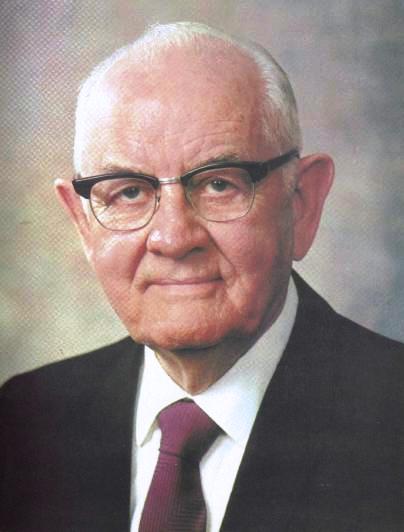 Spencer Kimball was an influential leader in church relations with Native Americans. Beginning in 1945 then apostle Spencer Kimball was assigned to be over church relations with Native Americans, and he would go on to become president of the church and was very influential in church actions and teachings around Native Americans for four decades until his death in 1985.[48]: 237 [49] Twentieth century teachings connecting modern Native Americans and Lamanites reached their height under the presidency of Spencer W. Kimball (1973 –1985),[50]: 159 then declined, but did not disappear.[51]: 157–159 For example in 1967, then apostle (later church president) Kimball stated that Native Americans were descendants of Middle Eastern settlers who traveled over the ocean, and were "not Orientals" of East Asian origin,[52] further quoting a previous First Presidency proclamation which said God, "has revealed the origin and the records of the aboriginal tribes of America, and their future destiny.-And we know it."[53] Kimball definitively stated in 1971, "The term Lamanite includes all Indians and Indian mixtures, such as the Polynesians ...." and, "the Lamanites number about sixty million; they are in all of the states of America from Tierra del Fuego all the way up to Point Barrows, and they are in nearly all the islands of the sea from Hawaii south to southern New Zealand."[51]: 159 [54] The 1981 edition of the Book of Mormon said Lamanites "are the principal ancestors of the American Indians".[50]: 159 No evidence of the large civilizations or battles described in The Book of Mormon have been found by anthropologists and archaeologists, and DNA studies of Native Americans show that they came from Asia during the latest ice age, and not from the Middle East.[7][55][56] |
20世紀 1835年から1947年までの間、LDS(末日聖徒キリスト=モルモン)教会の公式賛美歌集には、ネイティブアメリカンについて次のような歌詞が含まれ ていた。「そして、我々の種族は衰退した。怠惰なインディアンの心に...。そして、あらゆる地域の捕虜となった兄弟たちはみな、やって来るだろう。そし て、野蛮な習慣を捨て去るだろう。」「偉大なる精霊よ、赤い男の叫びを聞け!... 多くの月が過ぎる前に、あなた方の肌から暗闇の呪いが消え去るだろう」[44] 1975年、ジョージ・P・リーはネイティブ・アメリカンとして初めて末日聖徒イエス・キリスト教会の中央幹部となったが、1989年に破門され、 1994年には少女への性的虐待を認め有罪を認めた。[45] 1977年までに、末日聖徒イエス・キリスト教会は、 米国とカナダには4万5千人のネイティブアメリカン教会員がいると発表した(ローマカトリック教会を除く他のどのキリスト教宗派よりも多い数である) [46]。20世紀後半、LDS教会はワシャキーのように、ネイティブアメリカン教会員の居住地となっていた土地を民間企業に売却し、ネイティブアメリカ ンは他の保留地や近隣の町に移住せざるを得なくなった[47]。  スペンサー・キンボールは、教会とネイティブアメリカンとの関係において影響力のある指導者であった。 1945年から使徒であったスペンサー・キンボールは、教会とネイティブアメリカンとの関係を統括する任務に就き、その後教会の大管長となり、1985年 に亡くなるまでの40年間、教会のネイティブアメリカンに関する活動や教えに多大な影響を与えた。[48]: 237 [49] 20世紀の教えは、 現代のネイティブアメリカンとレーマン族を結びつける20世紀の教えは、スペンサー・W・キンボール(1973年~1985年在任)の会長在任中に最盛期 を迎え[50]:159、その後衰退したが、消滅はしなかった[51]:157-159。例えば、1967年に使徒(後に教会会長)となった キンボールは、ネイティブアメリカンは海を渡ってきた中東の入植者の子孫であり、東アジア起源の「東洋人ではない」と述べた。さらに、以前の大管長会の宣 言を引用し、神は「アメリカの先住民の起源と記録を明らかにし、彼らの未来の運命を示された。そして、我々はそれを知っている」と述べた。 キンボールは1971年に「レーマン人という用語は、ポリネシア人など、すべてのインディアンとインディアンとの混血を含んでいる」と断言し、「レーマン 人の人口は約6000万人で、彼らはティエラ・デル・フエゴからポイント・バロウズまでのアメリカ合衆国のすべての州に存在し、ハワイからニュージーラン ド南部までの海のほぼすべての島々にも存在している」と述べた。[51]:159[ 54] 1981年版のモルモン書では、レーマン人は「アメリカインディアンの主な祖先である」と述べている。[50]:159 モルモン書に記述されているような大規模な文明や戦いの痕跡は、人類学者や考古学者によって発見されていない。また、ネイティブアメリカンに関するDNA 研究では、彼らは最終氷河期にアジアからやって来たのであって、中東から来たのではないことが示されている。[7][55][56] |
| 21st Century The LDS Church altered statements after 2007 to say that Lamanites are "among the ancestors" rather than the "principal ancestors" of Native Americans.[57][7] Church manuals state that Christopher Columbus was inspired by God to sail to the Americas, and The Book of Mormon teaches that because the Lamanites sinned against God, they lost their lands and became "scattered and smitten". LDS-raised and ethnically native Alaskan Sarah Newcomb stated that this framing excuses the genocide of Native Americans during the post-Columbus European colonization of the Americas.[7] In 2021 an offered $2 million donation by the church to the First Americans Museum for a Native American family history center was declined.[58] |
21世紀 2007年以降、末日聖徒イエス・キリスト教会は、ラマニア人がネイティブ・アメリカンの「主な祖先」ではなく「祖先の一人」であると主張するよう声明を 変更した。[57][7] 教会のマニュアルでは、クリストファー・コロンブスが神の啓示を受けてアメリカ大陸に航海したとされ、モルモン書では、ラマニア人が神に対して罪を犯した ために土地を失い、「散らされ、打ち負かされた」と教えている。LDS教で育ち、民族的にはアラスカ先住民であるサラ・ニューカムは、この解釈は、コロン ブス以降のヨーロッパによるアメリカ大陸植民地化の過程で先住民が大量虐殺されたことを正当化するものであると述べている。[7] 2021年、教会が先住民の家族歴史センターのためにファースト・アメリカン・ミュージアムに200万ドルの寄付を申し出たが、断られた。[58] |
| Native American enslavement See also: Mormonism and slavery 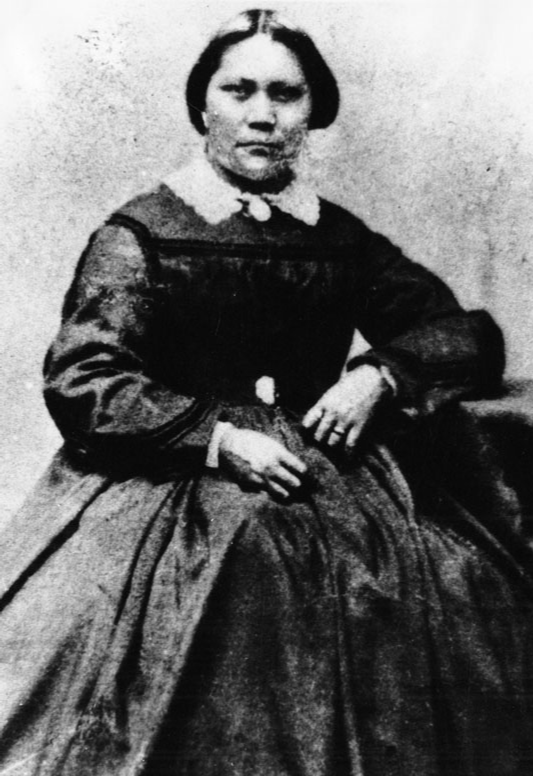 Kahpeputz was a slave in Brigham Young's household for over a decade.[59][60] The LDS Church's stance towards slavery alternated several times in its history, from one of neutrality, to anti-slavery, to pro-slavery. Smith had at times advocated both for and against slavery, eventually coming to take an anti-slavery stance later in his life. According to historian Andres Resendez, one of Smith's successors Brigham Young and other LDS leaders in Utah Territory leaders "did not so much want to do away with Indian slavery as to use it for their own ends."[28]: 272 Young officially legalized Native American slavery in the Utah Territory in 1852 with each purchased Native American person allowed to be held up to twenty years in indentured servitude.[28]: 272 [61] Children between seven and sixteen years old were supposed to be sent to school three months of the year, but were otherwise put to work.[28]: 273 Soon after Mormons colonized the Salt Lake Valley in 1847 child slaves became a vital source of their labor, and were exchanged as gifts.[61] Within a decade of settling the Salt Lake Valley over 400 Native American children were purchased and lived in Mormon homes.[61] In 1849 a posse of around 100 LDS men in southern Utah chased and killed twenty-five Native American men in retaliation for some cattle raids, and their women and children were taken as slaves.[28]: 274 Leader Brigham Young advocated buying children held by Native Americans and Mexican traders as slaves, and encouraged Latter-day Saints to educate and acculturate the children as if they were their own.[62][63][61] However, despite the requirement to educate the Native American indentured servants, the majority had received no formal education according to an 1860 census.[17]: 279 Young's spouse owned a Native American slave Kahpeputz. At age seven she was kidnapped from her Bannock family and tortured, and later purchased by Brigham Young's brother-in-law and gifted to one of Young's wives and renamed Sally.[60] She was a servant in the Young household for over a decade working long hours with the rest of the servants and was not taught to read or write.[59] While considering appropriations for Utah Territory, Representative Justin Smith Morrill criticized the LDS Church for its laws on Indian slavery. He said that the laws were unconcerned about the way the Indian slaves were captured, noting that the only requirement was that the Indian be possessed by a White person through purchase or otherwise. He said that Utah was the only American government to enslave Indians, and said that state-sanctioned slavery "is a dreg placed at the bottom of the cup by Utah alone".[64] The Republicans' abhorrence of slavery in Utah delayed Utah's entrance as a state into the Union. In 1857, Representative Justin Smith Morrill estimated that there were 400 Indian slaves in Utah.[64] Richard Kitchen has identified at least 400 Indian slaves taken into Mormon homes, but estimates even more went unrecorded because of the high mortality rate of Indian slaves. Many of them tried to escape.[28]: 273, 274 Slavery in Utah ended in 1862 when the United States Congress abolished it nationwide. In a 2020 general conference address church apostle Quentin Cook said of early church history, "Many [non-Mormon] Missourians considered Native Americans a relentless enemy and wanted them removed from the land. In addition, many of the Missouri settlers were slave owners and felt threatened by those who were opposed to slavery. In contrast, our doctrine respected the Native Americans, and our desire was to teach them the gospel of Jesus Christ. With respect to slavery, our scriptures had made it clear that no man should be in bondage to another."[65] |
ネイティブ・アメリカンの奴隷化 関連項目:モルモン教と奴隷制度  カペプツは10年以上にわたってブリガム・ヤングの家庭で奴隷として働いていた。[59][60] 奴隷制に対する末日聖徒イエス・キリスト教会の姿勢は、その歴史の中で何度か変化しており、中立から奴隷制廃止、奴隷制擁護へと変遷した。スミスは奴隷制 に賛成・反対の両方の立場を表明することがあったが、晩年には奴隷制廃止の立場を取るようになった。歴史家のアンドレス・レサンドゥによると、スミスの後 継者の一人であるブリガム・ヤングやユタ準州の他の末日聖徒イエス・キリスト教会の指導者たちは、「インディアンの奴隷制度を廃止したいというよりも、む しろ自分たちの目的のために利用したいと考えていた」という。[28]: 272 ヤングは1852年にユタ準州におけるネイティブ・アメリカンの奴隷制度を公式に合法化し、購入されたネイティブ・アメリカン一人につき、最長20年間の [28]: 272 [61] 7歳から16歳までの子供たちは、1年のうち3か月間は学校に通うことになっていたが、それ以外は労働に従事した。[28]: 273 1847年にモルモン教徒がソルトレイクバレーに植民地化してまもなく、児童奴隷は労働力の重要な供給源となり、贈り物として交換された。 61] ソルトレイクバレーに定住してから10年以内に、400人以上のネイティブアメリカンの子供たちが購入され、モルモン教徒の家庭で暮らすようになった。 [61] 1849年、ユタ州南部で、LDS教徒の男性約100人からなる一団が、家畜の略奪に対する報復として、25人のネイティブアメリカンの男性を追跡し、殺 害した。その女性と子供たちは奴隷として連れて行かれた。[28]: 274 指導者ブリガム・ヤングは、アメリカ先住民やメキシコの商人によって捕らえられた子供たちを奴隷として買い取ることを提唱し、末日聖徒たちに、その子供た ちを自分の子供のように教育し、文化に馴染ませることを奨励した。[62][63][61] しかし、 1860年の国勢調査によると、先住民の年季奉公人に教育を受けさせることが義務付けられていたにもかかわらず、大半は正式な教育を受けていなかった。 [17]:279 ヤングの配偶者は、先住民の奴隷カペプツを所有していた。7歳の時にバノック族の家族から誘拐され、拷問を受けた。その後、ブリガム・ヤングの義理の兄弟 が彼女を購入し、ヤングの妻の一人に贈り、サリーと名付けた。[60] 彼女は10年以上にわたってヤング家の使用人として、他の使用人たちとともに長時間働いたが、読み書きを教わることはなかった。[59] ユタ準州への予算配分を検討する中で、ジャスティン・スミス・モリル代議員は、LDS教会のインディアン奴隷制に関する法律を批判した。彼は、その法律は インディアンの奴隷がどのように捕獲されたかについては関知していないと述べ、インディアンが白人によって購入されるか、あるいはその他の方法で所有され ることが唯一の要件であると指摘した。彼は、ユタ州がアメリカ合衆国政府の中で唯一インディアンを奴隷化しているとし、州公認の奴隷制度は「ユタ州だけが コップの底に沈めたかすのようなもの」であると述べた。[64] ユタ州における共和党の奴隷制度への嫌悪感が、同州が連邦に加盟する時期を遅らせた。1857年、ジャスティン・スミス・モリル代議士はユタ州には400 人のインディアン奴隷がいると推定した。[64] リチャード・キッチンはモルモン教徒の家庭に連れてこられたインディアン奴隷は少なくとも400人いたと特定しているが、インディアン奴隷の死亡率が高 かったため、さらに多くの人数が記録されていないと推定している。彼らの多くは逃亡を試みた。[28]: 273, 274 ユタ州における奴隷制度は、1862年に米国議会が全国的に廃止したことにより、廃止された。2020年の総会での説教で、教会使徒クエンティン・クック は初期の教会の歴史について次のように述べた。「多くの(モルモン教以外の)ミズーリ州民はネイティブアメリカンを容赦ない敵と見なし、彼らを土地から追 い出そうとしていた。さらに、ミズーリ州の開拓者の多くは奴隷所有者であり、奴隷制度に反対する人々を脅威に感じていた。それに対して、私たちの教義はネ イティブアメリカンを尊重しており、彼らにイエス・キリストの福音を教えることを望んでいた。奴隷制度に関しては、私たちの聖典は、誰もが他の誰かに束縛 されるべきではないことを明確にしていた。」[65] |
| Violence See also: Mormonism and violence Battles See also: American Indian Wars § Great Basin Violence between Mormon adherents and Native Americans include the Black Hawk War, Ute Wars, Wakara's (Walker's) War, and Posey War. 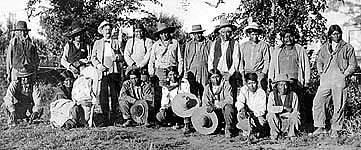 Ute and Paiute Native Americans involved in the 1923 Posey War in southeast Utah Massacres of Native American people by LDS adherents See also: List of Indian massacres in North America § 1830–1915 Timpanogos extermination order Main article: Battle at Fort Utah During the 1850 escalation to the Battle at Fort Utah, Brigham Young ordered his Deseret Territorial Militia to "go and kill" the Timpanogos people of Utah Valley, further stating, "We have no peace until the men [are] killed off—never treat the Indian as your equal". He clarified that the militia should "let the women and children live if they behave themselves."[66][67] Following this order was the "bloodiest week of Indian killing in Utah history."[68]: 54 By the end of the wintertime conflict over 100 Timpanogos Utes were killed by Young's forces, and 50 of their bodies were beheaded and their heads put on display for several weeks in Fort Utah as a warning to the 26 surviving Native American women and children prisoners from the conflict held there.[71] The prisoners were then distributed to LDS families to be used as slaves.[69]: 711 [72]: 76 Table of massacres 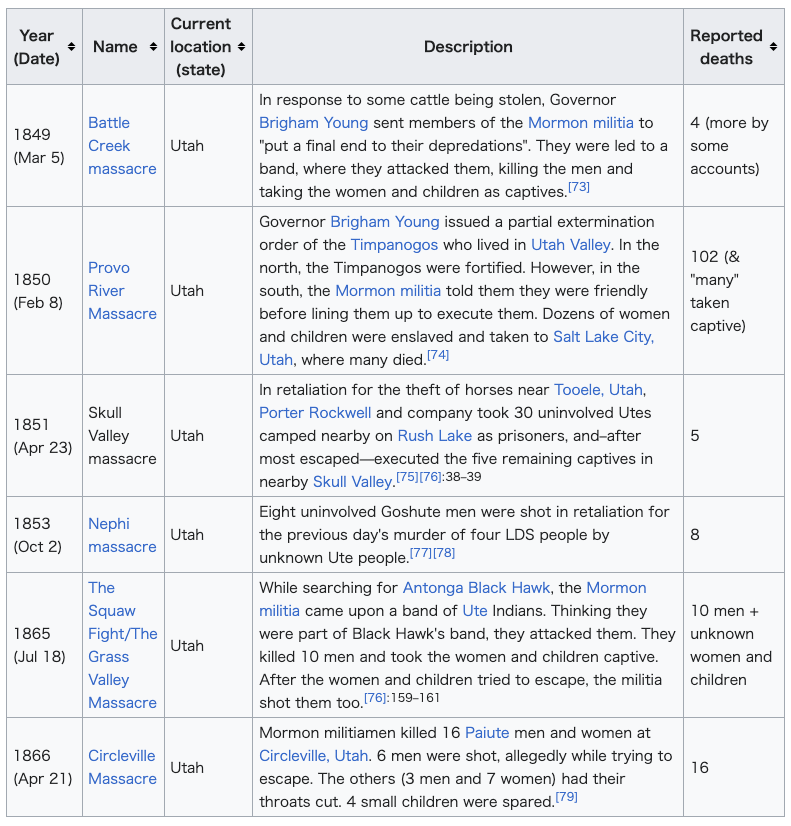 Massacres of LDS adherents by Native American people See also: List of Indian massacres in North America § 1830–1915  Mountain Meadows Massacre Main article: Mountain Meadows Massacre In 1857 LDS militiamen dressed up as Native Americans and recruited a smaller party of Southern Paiutes for a five-day siege on a wagon train of White pioneers travelling from Arkansas to California through Utah. The disguises were an attempt to shift blame for the aggression from White Mormon people onto the local Native Americans, and for many years after, the mass murder which became known as the Mountain Meadows Massacre was blamed on Paiute Indians.[81] During the militia's first assault on the wagon train, the emigrants fought back, and a five-day siege ensued. Eventually, fear spread among the militia's leaders that some emigrants had caught sight of the White men, likely discerning the actual identity of a majority of the attackers. As a result, militia commander William H. Dame ordered his forces to kill all the adults. 120 men and women, and all their children over the age of seven were slaughtered and their bodies left unburied.[82] The massacre almost pushed the US government into the Utah War with the LDS Church.[82] Bear River Massacre Main article: Bear River Massacre In 1863 (Jan 29) Col. Patrick Connor led a United States Army regiment killing up to 280 Shoshone men, women and children near Preston, Idaho under the urging of Mormon residents of Cache Valley, Utah after the killing of several cattle by Shoshoni men from Wyoming. The people of this camp had not been involved in the cattle killing. Refugees from this massacre moved into Box Elder County where they converted to Mormonism and eventually settled on church-owned property at Washakie, Utah.[83][84] |
暴力 関連項目:モルモン教と暴力 戦い 関連項目:アメリカインディアン戦争 § グレート・ベイスン モルモン教信者とネイティブアメリカンとの間の暴力には、ブラック・ホーク戦争、ユート戦争、ワカラ(ウォーカー)戦争、ポージー戦争がある。  ユタ州南東部で1923年に発生したポージー戦争に関与したユテ族とパイユート族のネイティブアメリカン 末日聖徒イエス・キリスト教会の信者によるネイティブアメリカン虐殺 関連項目:北米におけるネイティブアメリカン虐殺の一覧 § 1830年~1915年 ティンパノゴスの絶滅命令 詳細は「ユタ砦の戦い」を参照 1850年のユタ砦の戦いへのエスカレートのさなか、ブリガム・ヤングはデセレット準州民兵にユタバレーのティンパノゴス族を「皆殺しにせよ」と命じ、さ らに「男たちが殺し尽くされるまで平和はない。インディアンを対等の存在として扱うことは決してない」と述べた。彼は民兵に対して、「女性と子供は、おと なしくしていれば生かしておいてよい」と明確にした。[66][67] この命令に従って、「ユタ州史上、最も多くのインディアンが殺された血なまぐさい1週間」が続いた。[68]:54 冬の間の戦闘の末、ユングの軍勢によって100人以上のティンパノゴス・ユート族が殺され、 そのうち50人の遺体は斬首され、その頭部はフォートユタに数週間展示され、そこで収監されていた26人の生存していたアメリカ先住民の女性と子供たちへ の警告とされた。[71] その後、捕虜たちは末日聖徒の家族に分配され、奴隷として使役された。[69]: 711 [72]: 76 虐殺の一覧  ネイティブ・アメリカンによる末日聖徒イエス・キリスト教会信者の虐殺 参照:北米におけるインディアン虐殺の一覧 § 1830年~1915年  マウンテン・メドウズ虐殺 詳細は「マウンテン・メドウズ虐殺」を参照 1857年、LDS教徒の民兵がネイティブアメリカンの服装をし、さらに少数の南パイユート族を勧誘して、アーカンソーからユタを経由してカリフォルニア に向かっていた白人の開拓者たちの幌馬車隊を5日間包囲した。この偽装工作は、侵略行為の責任を白人モルモン教徒から地元のネイティブアメリカンに転嫁し ようとする試みであった。その後長年にわたり、マウンテン・メドウズ虐殺として知られるようになったこの大量殺人は、パイユート族のせいであると非難され た。[81] 民兵による幌馬車隊への最初の攻撃の際、移住者たちは抵抗し、5日間にわたる包囲戦となった。最終的に、民兵のリーダーたちの間に、一部の移民が白人の姿 を目撃し、おそらくは襲撃者の大半の正体を見破ったのではないかという不安が広がった。その結果、民兵隊司令官ウィリアム・H・デームは、成人全員を殺害 するよう命令を下した。120人の男女と7歳以上の子供全員が虐殺され、その死体は埋葬されなかった。[82] この虐殺事件により、アメリカ政府は末日聖徒イエス・キリスト教会とのユタ戦争に踏み切る寸前まで追い込まれた。[82] ベア・リバー虐殺 詳細は「ベア・リバー虐殺」を参照 1863年(1月29日)、ワイオミング州のショショーニ族の男性数名が家畜を殺したことを受け、ユタ州キャッシュ・バレーのモルモン教徒の住民の強い要 請により、パトリック・コナー大佐が率いるアメリカ陸軍連隊がアイダホ州プレストン近郊でショショーニ族の男女や子供280名を殺害した。このキャンプの 人々は、牛の殺害には関与していなかった。この虐殺から逃れた難民はボックス・エルダー郡に移住し、そこでモルモン教に改宗し、最終的にはユタ州ワシャ キーの教会所有地に定住した。[83][84] |
| Indian Placement Program Main article: Indian Placement Program The Indian Placement Program (also called the Indian Student Placement Program and the Lamanite Placement Program) was operated by the LDS Church in the United States, officially operating from 1954 and virtually closed by 1996. It had its peak during the 1960s and 1970s.[85] Native American students who were baptized members of the LDS Church were placed in foster homes of LDS members during the school year. They attended majority-White public schools, rather than the Indian boarding schools or local schools on the reservations. This was in line with the Indian Relocation Act of 1956. An LDS author wrote in 1979 that in southeast Idaho Native Americans from reservations were often treated with disdain by LDS and non-LDS White people.[15]: 378 [86] The program was developed according to LDS theology, whereby conversion and assimilation to Mormonism could help Native Americans.[16] An estimated 50,000 Native American children went through the program.[87][3] The foster placement was intended to help develop leadership among Native Americans and assimilate them into majority-American culture. The cost of care was borne by the foster parents, and financially stable families were selected by the church. Most of these placements took place on the Navajo Nation, with a peak participation of 5,000 students in 1972. The program decreased in size after the 1970s, due to criticism, changing mores among Native Americans, and restriction of the program to high school students as schools improved on reservations. In the 70s and 80s more Native Americans attended the church's Brigham Young University than any other major US institution of higher learning.[7] Many of the students and families praised the program; others criticized it and the LDS Church for assimilationist policies weakening the Native Americans' ties to their own cultures.[7] In the spring of 2015, four plaintiffs (now referred to as the "Doe Defendants") filed suit in the Window Rock District of the Navajo Nation Tribal Court, alleging they had been sexually abused for years while in the foster program, roughly from the years 1965 to 1983, and the LDS Church did not adequately protect them.[88] The LDS church filed suit in federal district court in Salt Lake City, alleging that the Tribal Court did not have jurisdiction and seeking an injunction "to stay the proceedings from moving forward under tribal jurisdiction."[88] Federal district court judge Robert Shelby denied the church's motion to dismiss and also ruled that it first had to "exhaust all remedies" in Tribal Court.[88] |
インディアン・プレースメント・プログラム 詳細は「インディアン・プレースメント・プログラム」を参照 インディアン・プレースメント・プログラム(インディアン学生プレースメント・プログラム、ラマナイ人プレースメント・プログラムとも呼ばれる)は、アメ リカ合衆国の末日聖徒イエス・キリスト教会によって運営されていたもので、1954年から公式に、1996年までに事実上閉鎖された。1960年代と 1970年代にピークを迎えた。[85] 洗礼を受けて末日聖徒イエス・キリスト教会の会員となったネイティブ・アメリカンの学生は、学校に通う間、末日聖徒イエス・キリスト教会の会員の里親に預 けられた。彼らは、居留地内のインディアン寄宿学校や地元の学校ではなく、白人多数派の公立学校に通った。これは1956年のインディアン移住法に沿った ものであった。1979年、LDSの著者は、アイダホ州南東部では、居留地に住むネイティブアメリカンは、LDS教徒や非LDS教徒の白人から軽蔑的な扱 いを受けることが多かったと書いている。[15]:378[86] このプログラムは末日聖徒イエス・キリスト教会の神学に従って開発されたもので、改宗とモルモン教への同化がネイティブアメリカンを救うことができるとい うものだった。[16] 推定5万人のネイティブアメリカンの子供たちがこのプログラムに参加した。[87][3] 里親制度はネイティブアメリカンにリーダーシップを育成させ、アメリカ文化に同化させることを目的としていた。 養育費は里親が負担し、教会によって経済的に安定した家庭が選ばれた。これらの里親制度のほとんどはナバホ国民の間で行われ、1972年には5,000人 の生徒が参加した。このプログラムは、批判やネイティブアメリカンたちのモラルの変化、保留地内の学校の改善に伴う高校生へのプログラムの制限などによ り、1970年代以降は縮小した。70年代と80年代には、ネイティブアメリカ人の多くが、教会のブリガム・ヤング大学に、米国の他の主要な高等教育機関 よりも多く進学した。[7] 多くの学生とその家族は、このプログラムを賞賛したが、他の人々は、ネイティブアメリカンが自らの文化とのつながりを弱める同化政策であるとして、このプ ログラムと末日聖徒イエス・キリスト教会を批判した。[7] 2015年春、4人の原告(現在は「ドゥー被告」と呼ばれる)が、ナバホ族のウィンドウロック地区の部族裁判所に訴訟を起こし、里親制度下にあった 1965年から1983年までの間、長年にわたって性的虐待を受け、LDS教会は彼らを十分に保護しなかったと主張した。 。LDS教会はソルトレークシティーの連邦地方裁判所に訴訟を起こし、部族裁判所には管轄権がないと主張し、「部族の管轄権下での訴訟手続きを停止する」 差し止め命令を求めた。[88] 連邦地方裁判所のロバート・シェルビー判事は、教会側の訴え却下の申し立てを却下し、また、教会はまず部族裁判所で「あらゆる救済措置を尽くす」必要があ ると裁定した。[88] |
| Teachings on Native American skin color See also: Mormon teachings on skin color 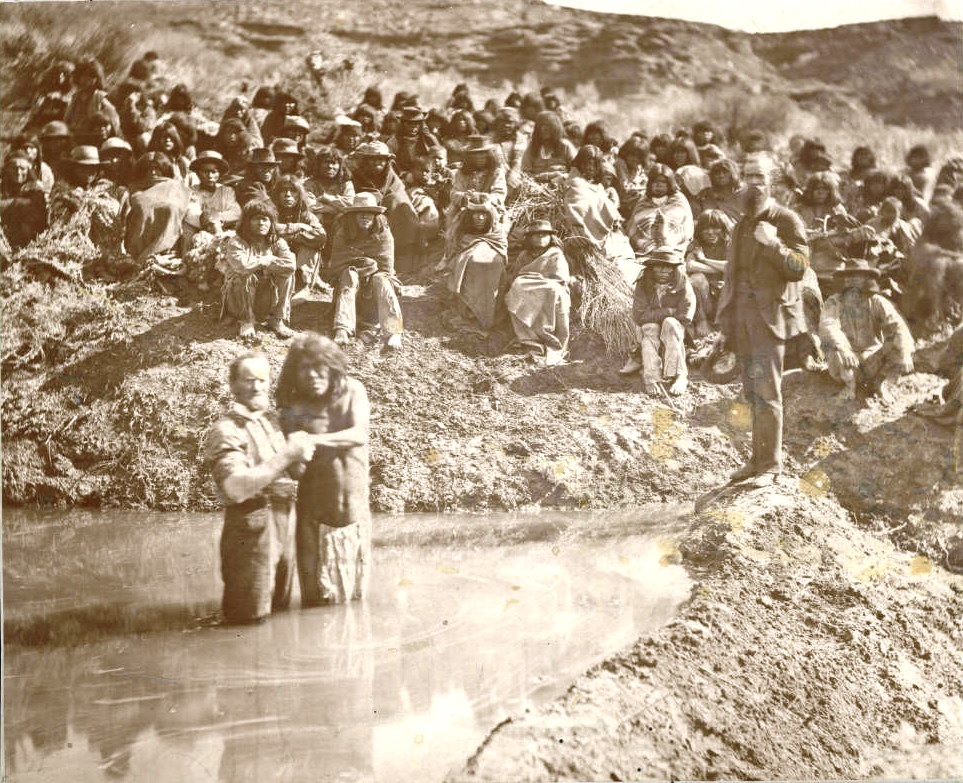 Shivwits Band of Paiute people being baptized into the LDS Church by White missionaries in 1875 Several church leaders have stated that The Book of Mormon teaches that Native Americans have dark skin (or the "curse of redness") because their ancestors (the Lamanites) were cursed by God, but if Native Americans follow church teachings, their dark skin will be removed.[89][2]: 205, 207 Not far into the narrative of The Book of Mormon God marks Lamanites (the presumed ancestors of Native Americans) with dark skin because of their iniquity, an act similar to the Bible's Curse of Cain which later some Protestants interpreted as the beginning of the Black race.[19]: 97–98 The Book of Mormon passage states, "[God] had caused the cursing to come upon [the Lamanites] ... because of their iniquity ... wherefore, as they were White, and exceeding fair and delightsome, that they might not be enticing unto my people [the Nephites] the Lord God did cause a skin of blackness to come upon them."[46][90] During the century between 1835 and 1947 the official LDS hymnbook had lyrics discussing a lightening of Native American skin color stating, "Great spirit listen to the Red Man's wail! ... Not many moons shall pass away before/ the curse of darkness from your skins shall flee".[91] They taught that in the afterlife's highest degree of heaven Native American's skin would become "white in eternity" like everyone else.[92][93] They often equated Whiteness with righteousness, and taught that originally God made his children White in his own image.[94]: 231 [95][93] A 1959 report by the U.S. Commission on Civil Rights found that most Utah Mormons believed "by righteous living, the dark-skinned races may again become 'white and delightsome'."[96] Conversely, the church also taught that White apostates would have their skins darkened when they abandoned the faith.[97] In 1953, President of the Quorum of the Twelve Apostles Joseph Fielding Smith stated, "After the people again forgot the Lord ... the dark skin returned. When the Lamanites fully repent and sincerely receive the gospel, the Lord has promised to remove the dark skin.... Perhaps there are some Lamanites today who are losing the dark pigment. Many of the members of the Church among the Catawba Indians of the South could readily pass as of the White race; also in other parts of the South."[98][99] Additionally, in a 1960 LDS Church General Conference, apostle Spencer Kimball suggested that the skin of Latter-day Saint Native American was gradually turning lighter.[100] Mormons believed that through intermarriage, the skin color of Native Americans could be restored to a "white and delightsome" state.[101][102]: 64 Navajo general authority George Lee stated that he had seen some Native American members of the church upset over these teachings and that they did not want their skin color changed as they liked being brown, and so he generally avoided discussing the topic. Lee interpreted the teachings to mean everyone's skin would be changed to a dazzling white in the celestial kingdom.[46] Kimball, however, suggested that the skin lightening was a result of the care, feeding, and education given to Native American children in the home placement program.[46] In 1981, church leaders changed a scriptural verse about Lamanites in The Book of Mormon from stating "they shall be a white and delightsome people" to stating "a pure and delightsome people".[43]: 71 [103] Thirty-five years later in 2016, the LDS Church made changes to its online version of The Book of Mormon in which phrases on the Lamanite's "skin of blackness" and them being a "dark, loathsome, and filthy" people were altered.[104][105] In 2020 controversy over the topic was ignited again when the LDS church's recently printed manuals stated that the dark skin was a sign of the curse and the Lord placed the dark skin upon the Lamanites to keep the Nephites from having children with them.[106] In recent decades, the LDS Church has condemned racism and increased its proselytization efforts and outreach in Native American communities, but it still faces accusations of perpetuating implicit racism by not acknowledging or apologizing for its prior discriminatory practices and beliefs. A 2023 survey of over 1,000 former church members in the Mormon corridor found race issues in the church to be one of the top three reported reasons why they had disaffiliated.[107] |
ネイティブアメリカンの肌の色に関する教え 参照:肌の色に関するモルモン教の教え  1875年にシビウィッツ・バンド・オブ・パイユート族が白人宣教師によって末日聖徒イエス・キリスト教会に洗礼を受けた 教会の指導者の中には、モルモン書はネイティブアメリカンが黒人(または「赤みの呪い」)であるのは彼らの先祖(レーマン人)が神に呪われたためだと教え ているが、もしネイティブアメリカンが教会の教えに従うならば、彼らの黒い肌は取り除かれると述べている者もいる。[89][2]: 205, 207 彼らの悪行を理由に、神は彼らに黒い肌を与えた。これは、後にプロテスタントの一部が黒人の起源と解釈した、聖書のカインの呪いに似た行為である。 [19]: 97-98 モルモン書の記述には、「神は彼ら(レーマン人)に呪いを与えた。それは彼らの悪行のためであった。それゆえ、彼らは白く、非常に美しく、 彼らが私の民(ニーファイ人)を誘惑することがないように、主なる神は彼らに黒い肌を授けられた」[46][90] 1835年から1947年の間の1世紀の間、LDS教会の公式賛美歌集には、アメリカインディアンの肌の色が薄くなることを歌った歌詞が掲載されていた。 「偉大なる精霊よ、赤い肌の男の叫びを聞け!... 汝らの肌から闇の呪いが消えるまで、多くの月日は過ぎないだろう」[91] 彼らは、死後の世界における最高の天国では、ネイティブアメリカンの肌は他の人々と同じように「永遠に白くなる」と教えた。[92][93] 彼らはしばしば白さを正義と同一視し、もともと神は神のイメージとして子供たちを白く創造したと教えた。[94]:2 31[95][93] 1959年の米国公民権委員会の報告書によると、ユタ州のモルモン教徒のほとんどが「正しい生活を送ることによって、肌の色が黒い人種は再び『白く、美し い』人種になる」と信じていたことが分かった[96]。逆に、教会は、信仰を捨てた白人の背教者は肌の色が黒くなるとも教えている[97]。 1953年、十二使徒定員会のジョセフ・フィールディング・スミス会長は、「人々が再び主を忘れた後、... 黒い肌が戻ってきた。レーマン人が完全に悔い改め、福音を心から受け入れるとき、主は黒い肌を取り除くことを約束された。おそらく今日、黒い色素を失いつ つあるレーマン人もいるだろう。南部のカタウバ・インディアンの教会員の多くは、白人として通用するほどであった。また、南部の他の地域でも同様であっ た。」[98][99] さらに、1960年の末日聖徒イエス・キリスト教会総大会で、使徒スペンサー・キンボールは、末日聖徒のネイティブ・アメリカンの肌の色が徐々に明るく なっていると示唆した。[100] モルモン教徒は、 混血によってネイティブ・アメリカンの肌の色は「白く美しい」状態に回復できると信じていた。[101][102]:64 ナバホ族の指導者ジョージ・リーは、これらの教えに動揺する教会のネイティブ・アメリカン信者を見たことがあり、彼らは褐色であることを好んでいるので肌 の色を変えたくないと述べ、そのためこの話題については一般的に避けていた。リーは、教えを解釈して、天国では誰もがまばゆいばかりの白い肌になるのだと 主張した。[46] しかしキンボールは、肌の色が白くなるのは、家庭配置プログラムでネイティブアメリカンの子供たちにケアや食事、教育が施された結果であると示唆した。 [46] 1981年、教会指導者たちはモルモン書におけるレーマン人に関する聖句を「彼らは白く、美しい民となるだろう」から「純粋で美しい民となるだろう」に変 更した。[43]:71[103] 35年後の2016年、末日聖徒イエス・キリスト教会はオンライン版の モルモン書』のオンライン版で、レーマン人の「黒い肌」と彼らが「暗く、嫌らしく、不潔な」人々であるという表現が変更された。[104][105] 2020年、このトピックに関する論争が再び再燃した。LDS教会が最近印刷したマニュアルで、その黒い肌は 、主がレーマン族にその肌の色を与えたのは、ニーファイ族が彼らとの間に子供を持つことを防ぐためであると述べたためである。[106] ここ数十年の間、末日聖徒イエス・キリスト教会は人種差別を非難し、アメリカ先住民のコミュニティにおける布教活動と奉仕活動を強化してきたが、依然とし て過去の差別的慣行や信念を認めず、謝罪しないことで、暗黙の人種差別を助長しているとの非難に直面している。2023年にモルモン教の信者密集地帯で 1,000人以上の元信者を対象に実施された調査では、教会における人種問題が、彼らが脱会した理由として報告された上位3つの理由の1つであることが分 かった。[107] |
| Marriages between Native Americans and White Latter Day Saints See also: Interracial marriage and the LDS Church 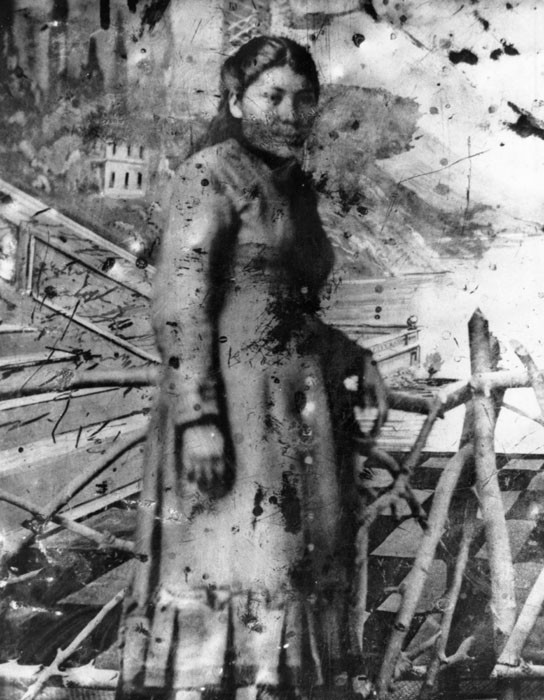 Jeanette Smith 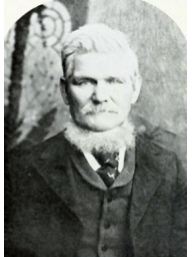 Dudley Leavitt 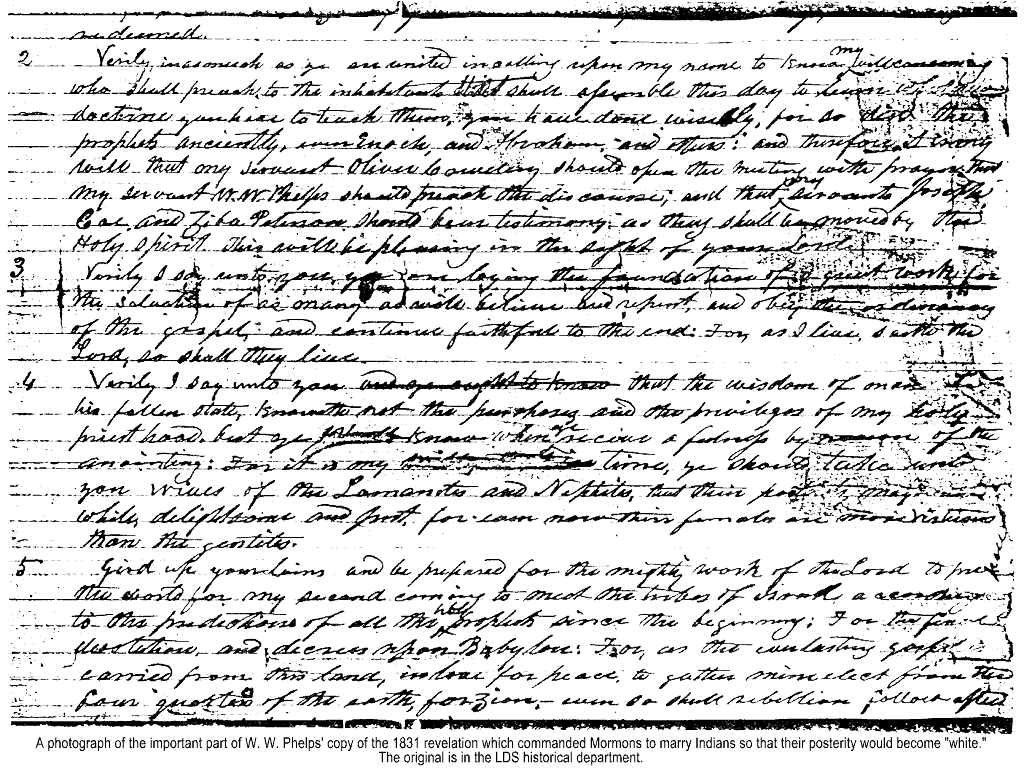 Native American Jeanette Smith married LDS, European American Dudley Leavitt in 1860. In the past, LDS Church leaders have consistently opposed marriages between members of different ethnicities, but today, interracial marriage is no longer considered a sin. Early Mormon leaders made an exception to the interracial marriage teachings by allowing White LDS men to marry Native American women because Native Americans were viewed as being descended from the Israelites; however, under Young, leaders did not sanction White LDS women marrying Native American men.[102]: 64 [101] In 1890 Native Americans made up only 1.6% of Utah's population.[33]: 112 In the 1930s many states had laws banning Native Americans from marrying White people, though, Utah did not.[33]: 106 The 1831 transcript of a revelation by Joseph Smith approving marriages between church members and Native Americans, stating "For it is my will, that in time, ye should take unto you wives of the Lamanites and Nephites, that their posterity may become white, delightsome and Just, for even now their females are more virtuous than the gentiles." On July 17, 1831, Smith said that he received a revelation in which God wanted several early elders of the church to eventually marry Native American women in a polygamous relationship so that their posterity may become "white, delightsome, and just".[108][109] Though Smith's successor Young believed that Native American peoples were "degraded", and "fallen in every respect, in habits, custom, flesh, spirit, blood, desire",[110]: 213 he also allowed Mormon men to marry Native American women as part of a process that would make their people White and delightsome and restore them to their "pristine beauty" within a few generations.[113] Many church leaders had different views on these unions, however, and they were rare, and those in these marriages were looked down upon by many LDS community members.[114]: 33 [28]: 276 Native American men were prohibited from marrying White women in Mormon communities.[101] Though, he would later oppose the marriage of Native American men to White LDS women, Young performed the first recorded sealing ceremony between any "Lamanite" and White member in October 1845 when an Oneida man Lewis Dana and Mary Gont were sealed in the Nauvoo Temple.[17]: 188 Though few in number, another notable example of a Native American man marrying an LDS woman at the time was the 1890 marriage of Ute violinist David Lemmon and Josephine Neilson in the St. George Utah Temple.[115] More common, however, was the experience of Tony Tillohash in the early 1900s who was rejected by the parents of a White LDS woman he proposed to, and was told to marry among his people.[28]: 276 [116]: 51 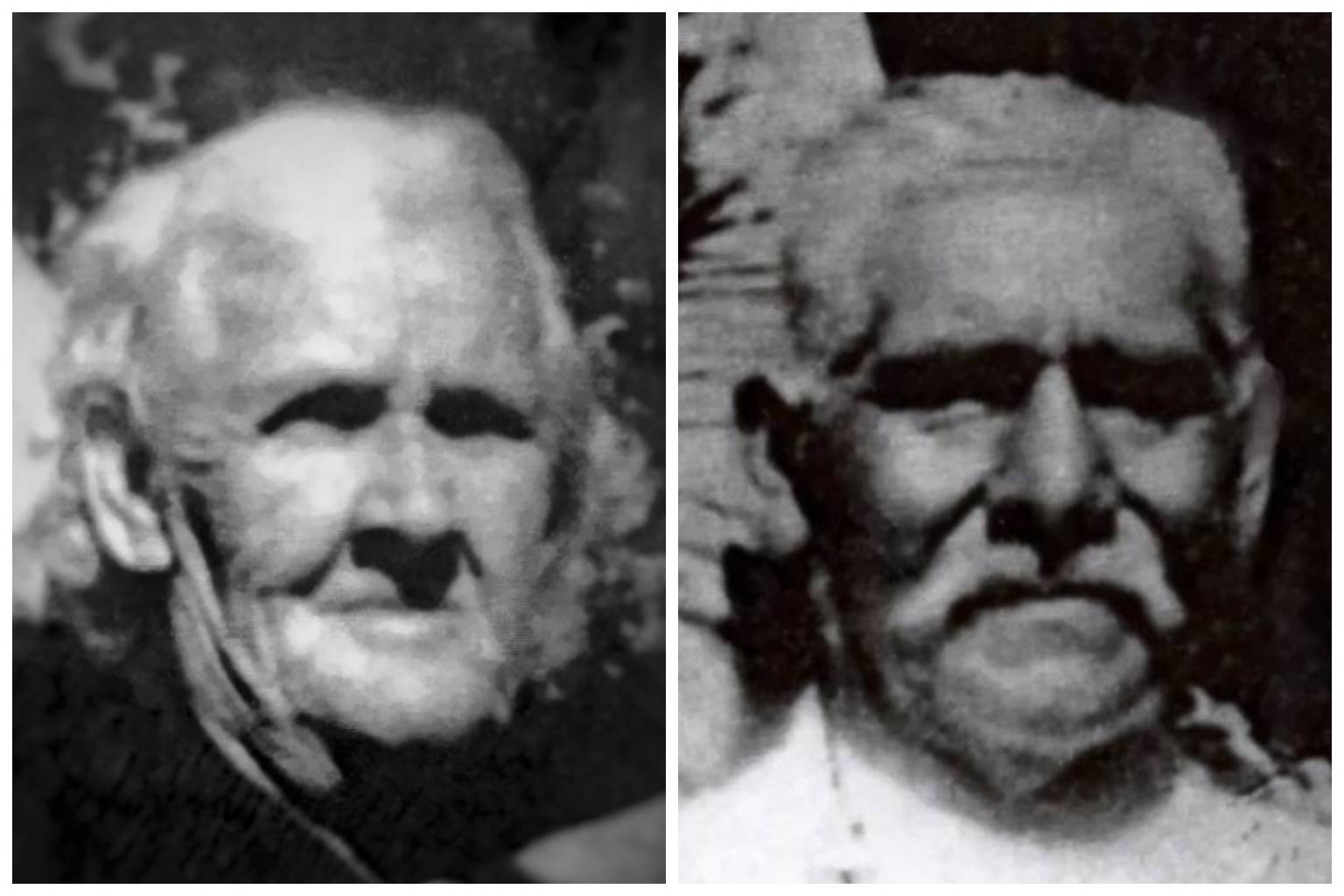 LDS couple Caroline Josephine Neilson and David Lemmon in Utah, circa mid-1920s There is evidence that Young may have married[60] his Bannock[117] servant[116]: 66 Kahpeputz (Sally) Young. Kahpeputz would later marry Ute chief Kanosh) in a temple,[112]: 195 [15]: 150 and they were both buried in their LDS temple robes, a custom for LDS members.[110]: 215–216, 348 By 1870 only about 30 Mormon men had Native American wives,[33]: 121 and few further interracial marriages with Native Americans occurred. Later Mormons believed that Native American skins would be lightened through some other method.[102]: 119 Under the presidency of Spencer W. Kimball, the church discouraged interracial marriages with Native Americans.[118] In 2013, the LDS Church disavowed previous teachings which stated that interracial marriage is a sin.[119][120] |
ネイティブアメリカンと末日聖徒イエス・キリスト教会の白人信者との結婚 参照:異人種間の結婚と末日聖徒イエス・キリスト教会  ジャネット・スミス  ダドリー・レビット  ネイティブアメリカンのジャネット・スミスは、1860年に末日聖徒イエス・キリスト教会の白人信者ダドリー・レビットと結婚した。 過去において、LDS教会の指導者たちは異なる民族間の結婚に一貫して反対してきたが、今日では異人種間の結婚はもはや罪とは見なされていない。初期のモ ルモン教の指導者たちは、アメリカ先住民がイスラエル人の子孫であると見なされていたため、白人LDS教徒の男性がアメリカ先住民の女性と結婚することを 認めることで、異人種間の結婚に関する教えに例外を設けていた。しかし、ヤングの下では、白人LDS教徒の女性がアメリカ先住民の男性と結婚することは認 められなかった。[102]: 64 [101 1890年には、ユタ州の人口に占めるネイティブアメリカンの割合はわずか1.6%であった。[33]: 112 1930年代には、多くの州でネイティブアメリカンと白人の結婚を禁じる法律が制定されていたが、ユタ州では制定されなかった。[33]: 106 1831年、ジョセフ・スミスによる教会の信者とネイティブアメリカンとの結婚を認める啓示の記録には、「汝ら、やがてはレーマン人とニーファイ人の妻を 迎え、彼らの子孫が白人となり、善良で公正な者となるようにせよ。なぜなら、今でも彼らの女性は異教徒よりも徳が高いからだ」と記されている。 1831年7月17日、スミスは神から啓示を受け、教会の初期の長老数名が最終的にアメリカ先住民の女性と一夫多妻の関係で結婚し、彼らの子孫が「白く、 快活で、公正な」人々になることを望んでいると述べた。[108][109] スミスの後継者であるヤングは、アメリカ先住民は「 堕落した」存在であり、「習慣、風習、肉体、精神、血統、欲望のあらゆる面で堕落した」存在であると考えていたが[110]: 213、モルモン教徒の男性がネイティブアメリカンの女性と結婚することを認め、数世代のうちに彼らの人種を白く、魅力的にし、彼らの「純粋な美しさ」を 回復させるためのプロセスとしていた。[113] しかし、教会指導者の多くはこれらの婚姻について異なる見解を持っており、また、これらの婚姻はまれであったため、これらの婚姻関係にある人々は多くの末 日聖徒のコミュニティのメンバーから見下されていた。[114]: 33 [28]: 276 ネイティブアメリカンの男性は、モルモン教のコミュニティにおいて白人女性との婚姻を禁じられていた。[101] しかし、後にネイティブアメリカンの男性と末日聖徒の白人女性との婚姻に反対する立場を取るものの、 1845年10月、オナイダ族のルイス・ダナとメアリー・ゴンツがノーブー神殿で結び固められたとき、ヤングは「レーマン人」と白人の会員との間で記録に 残る最初の結び固め式を執り行った。[17]:188 人数は少ないが、当時ネイティブアメリカンの男性が末日聖徒の女性と結婚したもう一つの注目すべき例は、1890年のユタ族のバイオリン奏者 ユタ州セントジョージ神殿で、ユタ族のバイオリン奏者デビッド・レモンとジョセフィン・ニールソンが結婚した例がある。[115] しかし、より一般的だったのは、1900年代初頭にトニー・ティロハッシュが経験したことである。彼はプロポーズした白人のLDS女性の両親に断られ、自 分の民族の中で結婚するように言われた。[28]: 276 [116]: 51  ユタ州在住のLDS教徒のカップル、キャロライン・ジョセフィン・ニールソンとデイビッド・レモン、1920年代半ば頃 ヤングがバノック族[117]の召使い[116]であったカペプツ(サリー)・ヤングと結婚した可能性があるという証拠がある。カペプツは後にユテ族の族 長カノッシュと神殿で結婚した。[112]:195[15]:150 そして二人は末日聖徒イエス・キリスト教会の会員の慣習に従い、末日聖徒イエス・キリスト教会の祭服をまとって埋葬された。[110]:215- 216,348 1870年までに、モルモン教徒の男性でアメリカインディアンの妻を持つ者は約30人となった。[33]:121 それ以降、アメリカインディアンとの異人種間の結婚はほとんど行われなかった。その後、モルモン教徒は、ネイティブアメリカンの肌の色は他の方法で薄くな るだろうと信じるようになった。[102]: 119 スペンサー・W・キンボール会長の時代には、教会はネイティブアメリカンとの異人種間の結婚を奨励しなくなった。[118] 2013年、末日聖徒イエス・キリスト教会は、異人種間の結婚は罪であるとする過去の教えを否定した。[119][120] |
| Other Latter Day Saint groups' teachings In 1920, what was then the Reorganized Church of Jesus Christ of Latter Day Saints (now called the Community of Christ), published a pamphlet titled Whence Came the Red Man which summarized The Book of Mormon stating, "two great camps ... began to quarrel bitterly among themselves. Part of them became the color of fine copper and the red brethren fought against the white."[121]: 65–66 |
末日聖徒の他のグループの教え 1920年、当時再編末日聖徒イエス・キリスト教会(現コミュニティ・オブ・クライスト)は、モルモン書を要約したパンフレット『レッドマン(インディア ン)の起源』を出版し、「2つの大きな集団が...互いに激しく争い始めた。彼らの一部は美しい銅色になり、赤い肌の兄弟たちは白人と戦った」と述べた。 [121]:65-66 |
| Black people and Mormonism Criticism of the Church of Jesus Christ of Latter-day Saints Curses of Cain and Ham and the LDS Church Mormonism and Pacific Islanders Genetics and the Book of Mormon Archaeology and the Book of Mormon Criticism of the Book of Mormon Phrenology and the Latter Day Saint Movement |
黒人とモルモン教 末日聖徒イエス・キリスト教会に対する批判 カインとハムの呪いと末日聖徒イエス・キリスト教会 モルモン教と太平洋諸島民 遺伝学とモルモン書 考古学とモルモン書 モルモン書に対する批判 骨相学と末日聖徒イエス・キリスト運動 |
| https://en.wikipedia.org/wiki/Native_American_people_and_Mormonism |
リ ンク
文 献
そ の他の情報
Copyleft, CC, Mitzub'ixi Quq Chi'j, 1996-2099
☆
 ☆
☆